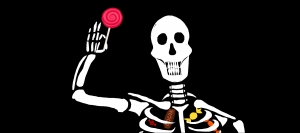#59 Trick Or Treat!
Hey Food Buffs! We're going to explore the history of Halloween and the vague beginnings of trick-or-treating!
We called Professor Nick Rogers, who wrote the book “Halloween: From Pagan Ritual to Party Night”. Coming from England, Professor Rogers didn't celebrate Halloween as a kid, but he got interested when he had children of his own and took them trick-or-treating. Then he learned all about Halloween, then we learned all about Halloween from him, and now you're going to learn all about Halloween from us!
Halloween - Two Celebrations Rolled Into One
There’s always some argument about the origins of things, but it is commonly accepted that the origins of Halloween traces back to a Celtic holiday, called “Samhain”, from Ireland. The Celts celebrated Samhain at the end of October, through to the beginning of November. For the Celts, the end of October was also the end of the year - their new year started on Nov. 1st. The end of October was also the end of summer, and the end of their harvest. If you think about what this must have meant to people who lived off the land, the time around Oct. 31st would have been a time to think about the trials of winter - a time to think about darker, colder days, and the difficulties of survival. Basically, a time to think about death. It was believed to be a time when the boundary between our world and the spirit world was so thin that spirits could pass through and roam amongst the living. So there was a practice of dressing up as spirits and being mischievous, that came from Samhain. It was a spiritual time, with bonfires built to pray for the sun to return, blood sacrifices offered to the gods to thank them for the harvest, and druids divining the future.
By the way, in ancient Rome, at a similar time in history, the Romans celebrated Pomona - a night named after the goddess Pomona to thank her for the harvest. As the Romans conquered more of Europe, they also spread the celebration of Pomona, and eventually the two celebrations, Pomona and Samhain were mixed into one another.
Stamping Out the Pagan Roots
But of course, these were pagan holidays, and as Christianity emerged, there was a great distrust of paganism. Rather than attempt the colossal task of stamping out pagan practices, there was the idea that these practices could be adapted to fit Christianity. So Pope Gregory the 3rd claimed November 1st as “All Saints Day” - a day to honor the saints. In this way, people could still celebrate around the time of Nov. 1st, but start celebrating All Saints Day instead of Samhain. By the way, All Saints Day, is also known as All Hallows Day, which is also known as Hallowmas. The day before Nov. 1 (ie. Oct. 31st) became known as “All Hallow’s Evening”...and you can see how that could eventually become the word “Halloween”.
Trick-or-treating is similar to an old practice called "threshold encounters". With threshold encounters, people would come to your door, and usually there's an exchange of some sort. It was mainly the less wealthy people going to the doors of more wealthy people, to pray for souls in return for food and refreshment. In Medieval times they believed that if you prayed hard enough for the souls of the dead, you could get them to heaven.
Hand Over the Candy!
Over time, the holiday became increasingly commercial. In the late 1800s, there were advertisements for things like apples, nuts, and sometimes grapes for Halloween (back then, grapes were a treat because they weren't as common). By the 1920s, the holiday was starting to take on its modern form. The earliest source we could find that referenced the term “trick or treat” in print was in 1927. In a 1927 edition of Herald, from Alberta, Canada, it said “The youthful tormentors were at back door and front demanding edible plunder by the word “trick or treat” to which the inmates gladly responded and sent the robbers away rejoicing.”
In the 1950s, that’s when Halloween was really associated with candy. Before that, candy companies really focused on the other holidays, like Christmas and Easter. In the beginning of trick-or-treating, you could get money, toys, baked goods, all sorts of things - it didn’t have to be candy. But when candy companies marketed candy for Halloween, it was an easy sell - candy is cheap, easy to hand out, and keeps for a long time. Especially with growing fears of homemade treats being poisoned, factory-produced candies are now the only way to go. With the occasional bag of chips or can of pop.
Special Thanks To Our Interviewee:
Professor Nick Rogers - author of “Halloween: From Pagan Ritual to Party Night”

